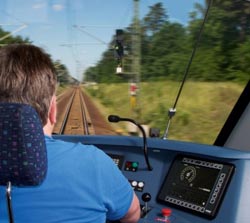Solar-powered Technology for the Swiss Railroad

In a contract scheduled to run until 2017, some 430 switch towers and over 9,000 signaling elements are to be upgraded in line with the European Train Control System (ETCS).
More than half of the lineside electronic units supplied are to be powered exclusively by solar cells and will therefore be energy self-sufficient. Compared to an installation of conventional solutions, this will result in power savings for SBB of over 850,000 kilowatt-hours a year. The order is worth a total of €125 million and also covers support for the installed signaling systems over a period of 25 years.
Train control systems supplement the visible signals used to inform train drivers whether they can proceed and the speed at which they may travel. Such systems also transmit signals by radio and, if the driver does not react, automatically apply the brakes of the train. There are currently around 20 incompatible train control systems in use on Europe's railroads. As a consequence, locomotives often have to be switched at borders. The ETCS creates a standard and is used for all new installations. Any upgrades of existing track and trains are carried out as required.
Trainguard from Siemens Mobility and Logistics provides a complete portfolio of solutions for fitting trains and tracks with ETCS-compatible equipment. The elements of the system include so-called Eurobalises — radio beacons mounted on the track to transmit data to an antenna fixed under the train — and lineside electronic units, which transmit information to the balises.
Faced with the need to upgrade its existing signaling systems, SBB opted to switch to ETCS. One major challenge is to replace existing train control systems without a power supply. These serve to transmit a total of three signals — “Go,” “Stop,” and “Warning” — to the train via magnetic induction. To solve this problem, Siemens has developed a lineside electronic unit equipped with solar cells that generate sufficient energy to transmit information.
This solution not only reduces overall electricity consumption but also saves the cost of installing cables to over 5,000 signaling elements. In areas where more complex data, such as speed information, has to be transmitted, conventional lineside electronic units have been installed. The upgrade will also implement a standard for the switchgear installed in 430 switch towers, where three generations of technology are in use.
Media Contact
More Information:
http://www.siemens.com/innovationnewsAll latest news from the category: Power and Electrical Engineering
This topic covers issues related to energy generation, conversion, transportation and consumption and how the industry is addressing the challenge of energy efficiency in general.
innovations-report provides in-depth and informative reports and articles on subjects ranging from wind energy, fuel cell technology, solar energy, geothermal energy, petroleum, gas, nuclear engineering, alternative energy and energy efficiency to fusion, hydrogen and superconductor technologies.
Newest articles

Optimising the processing of plastic waste
Just one look in the yellow bin reveals a colourful jumble of different types of plastic. However, the purer and more uniform plastic waste is, the easier it is to…

Anomalous magnetic moment of the muon
– new calculation confirms standard model of particle physics. Contribution of hadronic vacuum polarization determined with unprecedented accuracy. The magnetic moment of the muon is an important precision parameter for…

Antibodies can improve the rehabilitation of people with acute spinal cord injury
Antibody that Neutralizes Inhibitory Factors Involved in Nerve Regeneration Leads to Enhanced Motor Function after Acute Spinal Cord Injury. Researchers at 13 clinics in Germany, Switzerland, the Czech Republic and…



